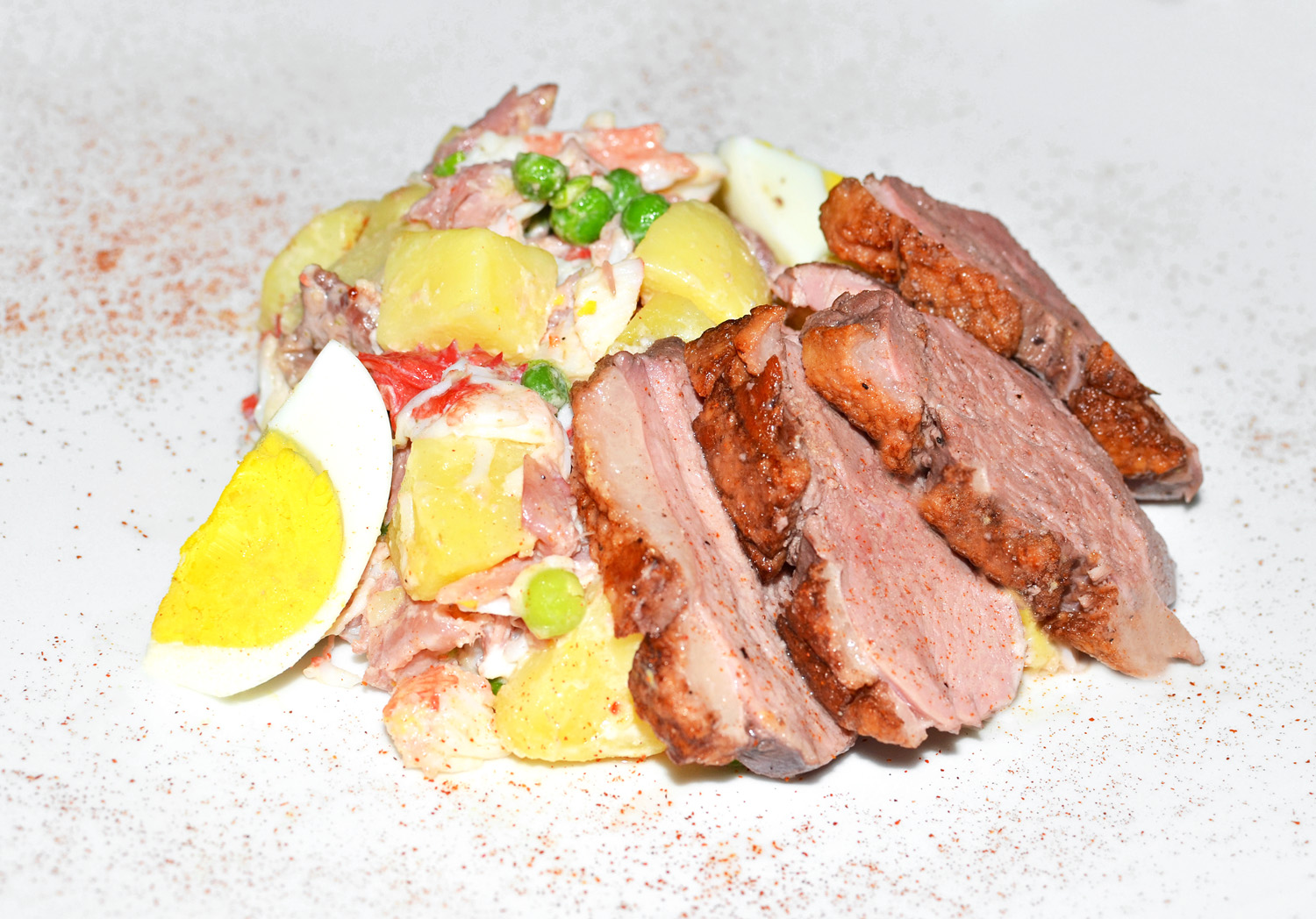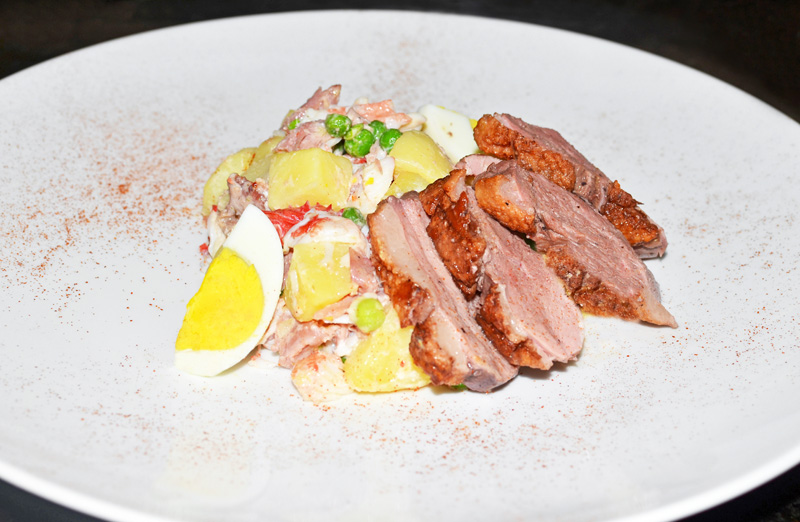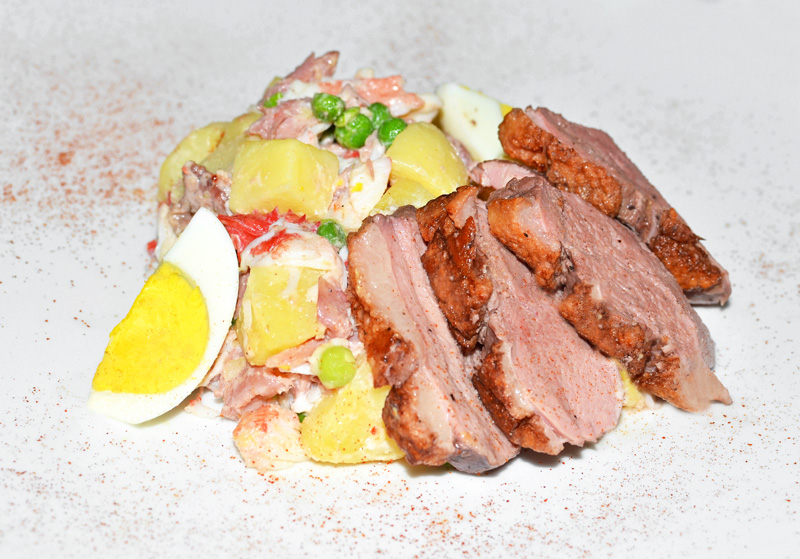After my recent complaints about the lack of originality of Onegin‘s salad Olivier, I figured I would bring my humble contribution to this Russian salad’s already extensive literature.
Salad Olivier can contain many ingredients, but it is at its core a potato salad with a variety of vegetables and proteins, bound by mayonnaise. It was invented in the second half of the 19th century by Chef Lucien Oliver at the restaurant Hermitage in Moscow. Although the recipe was secret, there are many versions circulating, with possible seasonal variations. Here’s one from the site of the School of Russian and Asian Studies:
Olivier Salad (“Tsarist” version)
This early recipe for Olivier salad, prepared during the height of the Hermitage restaurant’s
popularity (this recipe was written out in 1904, according to the description of one of the
restaurant’s frequent customers):
1 boiled veal tongue
Approx 100 grams of black caviar
200 grams of fresh lettuce leaves
25 boiled crayfish or one large lobster
200-250 grams of small gherkins
Half a can of “soy kabul” (soy paste)
2 thinly sliced fresh cucumbers
100 grams of capers
5 finely chopped hard-boiled eggs
- Provencal Sauce: beat 400 grams of olive oil with two egg yolks until light and smooth, then add French vinegar and mustard
- Chop up all the ingredients into small cubes. Mix in the Provencal Sauce.
In A Gift to Young Housewives, Elena Molokhovets gives a very vague recipe:
Take various cooked meats: game of wild fowl; veal or beef; or boiled fish such as sturgeon,
pike or salmon.
There follows a long procession of ingredients, from cucumbers to sauerkraut, mixed with diced potatoes in a mustard sauce. This may be a lot of ingredients for a single salad, but a) that was true about the original, too, and b) the refinement was still there.
Then things started to go downhill for Mr. Olivier’s signature dish. As it transitioned from decadent high-end restaurant dish to housewives’ meal, ingredients were drastically simplified. Limited ingredient availability in the Soviet Union would go on to further aggravated the matter, turning the salad into an assembly of mostly factory-produced food items. Here’s another recipe from the site of the School of Russian and Asian Studies:
Olivier Salad (“Soviet” version)
Potatoes (boiled and peeled)
Canned green peas
Pickles
Bologna
Hard-boiled eggs
Mayonnaise
- Chop up all the ingredients into small cubes. Mix in mayonnaise. Add fresh dill, salt and pepper to taste, if desired.
I have to wonder what’s the scariest thing in this recipe: the canned peas that traumatized generations of children, the mystery meat bologna, or the fact that all ingredients, mayonnaise included, are used in equal amounts!
So! I wanted to create a recipe for special occasions that restored some of the splendor of the original, but without combining as many flavors. A lot of the original elements have been preserved: a full-flavored bird (a whole duck), some seafood (my favorite king crab legs), a mayo made with mustard and olive oil, and of course diced potatoes. The proportions are well balanced so that you can taste each of them. Looking back at the result now, I’m thinking I could push the envelope a little bit more by adding sautéed cubes of foie gras…
While there are a lot of steps in this recipe, each of them is easy. Since I’m using a whole duck, chances are you will not get the exact amounts of breast, legs and thighs specified below, which is fine. You can prepare the duck confit one or two days ahead, but I would try to time the breast to finish cooking just a bit before service. The rest of the salad can be assembled a few hours beforehand. The smoked salt I’m using is the Yakima applewood smoked salt by Artisan Salt Co.
Duck fabrication
Yields 6 servings + rendered fat and stock
1 duck, about 6 lb
- Separate the wings and legs from the carcass, and reserve. Cut the breast from the carcass, trim the extra fat, and reserve.
- You can render the extra duck fat and freeze it, and use the carcass and the neck to make duck stock.
Duck confit
Yields 6 servings
duck legs and wings (about 2 lb)
0.5 % curing salt
1.5 % smoked salt
0.25 % fennel pollen
0.5 g black pepper
1 thinly sliced garlic clove
- Weigh the duck legs and wings, and measure the above percentages of that weight in curing salt, smoked salt, and fennel pollen. (The amount of black pepper is so small that it is more practical to measure it in grams.) Season the meat with the curing salt, smoked salt, fennel pollen, and black pepper. Place into sous-vide pouches with the garlic, and cook in a water bath at 171 F for 12 hours.
- Let cool, then remove the skin and bones. Transfer the meat to a plastic container, add a couple tablespoons of liquid from the sous-vide pouches, and refrigerate.
Duck breast
Yields 6 servings
duck breast (about 1 1/4 lb)
1.5 % smoked salt
black pepper, ground
1 1/2 oz red wine
4 oz duck skin
- Weigh the duck breast, and measure the above percentage of that weight in smoked salt. Cut a cross-hatch pattern on the skin of the duck breast, and sear in a very hot pan, skin side down, until brown and crispy. Remove from the pan, season with the smoked salt and black pepper, and place into a sous-vide pouch with the red wine and duck skin. Cook in a water bath at 136 F for 3 hours.
- Let cool to room temperature and reserve.
King crab fabrication and crab oil
Yields 6 servings + some extra crab oil
2 lb cooked king crab legs, shell on
2 tbsp olive oil
2 tbsp cognac (or Armenian brandy)
12 oz canola oil
- Pick the meat from the crab legs and reserve in the refrigerator.
- Cut the shell into small pieces, and sauté with the olive oil in a large saucepan. Add the cognac and light with a match. Add the canola oil, simmer over low heat for 15 minutes, then remove from heat and let steep for another 15 minutes.
- Pass through a chinois, let cool and reserve.
Mayonnaise
Yields 6 servings
1 egg yolk
1 tbsp mustard
salt
1/4 tsp piment d’espelette
6 oz crab oil
3 oz light olive oil
- In a bowl, mix the egg yolk, mustard, salt, and piment d’espelette with a whisk.
- Add the crab oil followed by the olive oil in a thin stream, whisking constantly. Refrigerate.
Potato salad
Yields 6 servings
4 1/2 oz frozen green peas
1 1/2 lb peeled Yukon Gold potatoes
salt
6-7 tbsp mayonnaise
king crab meat
duck confit
- Defrost the green peas in the refrigerator for a few hours.
- Cook the potatoes in cold salted water for about 25 minutes, until done. Drain and let cool to room temperature.
- Cut the potatoes into medium to large dice and adjust the seasoning. In a bowl, mix the potatoes with the peas and mayonnaise. Shred the crab meat and duck confit between your fingers, mix into the salad and refrigerate.
Assembly
Yields 6 servings
Potato salad, taken out of the refrigerator 30 minutes in advance
6 eggs, hard-boiled and cooled to room temperature
duck breast, room temperature
- Distribute the potato salad between the plates. Quarter the hard-boiled eggs and arrange around the salad.
- Take the duck breast out of the sous-vide pouch, slice on a bias, and fan the slices on top of the salad, pouring a spoonful of cooking liquid on top of the meat on each plate.
- Serve immediately.




3 comments
Hah! I consider myself Russian, but have never heard of the “Tsarist” version! It looks simply delicious! Will try on my relatives when they come for a visit! Will see if their palate is up to royal standards…
Hi Florian!
Your blog is piece of art!
I love reading your recipes especially Russian, since I’m Russian Ukranian.
When I make olivie at home we always add roasted or boiled carrots and sweet onion either white or red.
Thanks for inspiring chef! Keep posting amazing recipes!
I love this salad, and the topic itself is fascinating! I’m from Italy, where Olivier is known as Russian Salad (Insalata Russa), and till I moved the US and made Russian friends, I didn’t know it wasn’t just a name, but it was actually known in Russia!
I have my own recipe, and throughout Italy you may find slight variations. In mine, I use, in addition to potatoes and peas, carrots, green beans, hard-boiled egg, and small cornichons and onions, that give the salad a more sour taste which I personally like.
The wikipedia page for it (in italian) does have a multitude of possible origins https://it.wikipedia.org/wiki/Insalata_russa , unlike the Olivier page on english wiki. I really don’t know what’s right or not, and I don’t know if it’s relevant anyway… 🙂 I just love it and thought I’d give you a different point of view! All the best!